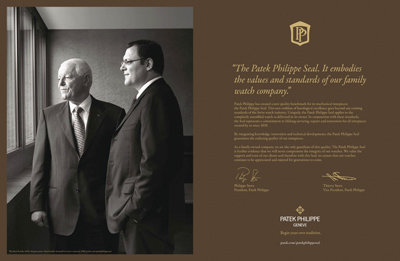Press Release, March 2009

A new era begins for Patek Philippe in the spring of 2009: All of the manufacture's mechanical movements will henceforth be embossed with the exclusive Patek Philippe Seal. This is the evolution of a philosophy of quality and independence that the workshops in Geneva have been systematically pursuing since the company was founded in 1839. The new label clearly expresses the very essence and distinctiveness of Patek Philippe: a level of perfection that far transcends what external statutes and official standards prescribe. After all, true passion can only come from within.
The Patek Philippe Seal: a logical step forward
For more than a century, the criteria of the Geneva Seal were observed in the development and completion of Patek Philippe's mechanical movements, defining the minimum quality levels to be attained. But true to its tradition of ongoing innovation, the manufacture never stopped its quest for continuous improvements in regards to the performance of its timepieces.
Patek Philippe is a “complete” manufacture that not only sustains a unique level of vertical integration in movements but also produces its watch cases and other key exterior elements in-house. Thus, the quality specifications at Patek Philippe relate not merely to the movements but to the entire finished watch. It is undisputed that a hallmark of quality must apply to the whole watch. This fact called for a new seal that defines all competencies and features of relevance to the manufacture, precision, and lifelong maintenance of a Patek Philippe timepiece. 
The Patek Philippe Seal: a mark of excellence that applies to the entire watch
The Patek Philippe Seal announced by the Geneva workshops is the watch industry's most exclusive and stringent hallmark of quality. The rules apply to all of the manufacture's movements regardless of their complexity. It not only applies to the movements: it encompasses cases, dials, hands, pushers, spring bars for straps, etc., as well as the aesthetic and functional aspects of the finished watches.
Moreover, given the fact that a Patek Philippe watch is first and foremost an instrument that measures time, the Patek Philippe Seal makes a binding statement regarding rate accuracy.
The stability of the rate of Patek Philippe timepieces is checked in several phases during the manufacturing process, initially with uncased movements, later with finished watches. The final rate accuracy measurement of the cased watch is performed with kinetic simulators and must comply with the following in-house precision standards:
- for calibers with diameters of 20 mm or more, the rate accuracy must lie within the range of -3 and +2 seconds per 24 hours.
- for calibers with diameters of less than 20 mm, the rate accuracy must lie within the range of -5 and +4 seconds per 24 hours.
Patek Philippe watches with tourbillon are subject to the same in-process inspections as all other mechancial timepieces, but they must comply with tighter tolerances as follows:
- Their rate accuracy as measured during the final inspection with kinetic simulators must lie within the range of -2 and +1 seconds per 24 hours.
- The greatest deviation between the average rate of the watch in all six measuring positions and the rate in each position must not exceed 4 seconds per 24 hours.
The rate accuracy of each Patek Philippe watch with a tourbillon is documented with an individually issued certificate delivered with the watch.
Another important aspect: In compliance with the in-house accuracy criteria, the final rate tests at Patek Philippe are performed with fully assembled watches as opposed to conventional tests with uncased movements.
The Patek Philippe Seal also reflects the tradition of innovation
In its quest for the highest possible level of quality, the manufacture does not tolerate compromise. This is why all qualitative aspects are subject to constant refinement. Patek Philippe strives to enhance value and long-term reliability. Thus, the Patek Philippe Seal is a dynamic quality label: its set of rules accommodates current and future developments that are suitable for the advancement of timekeeping.
The Patek Philippe Seal is the personal commitment of a family business
The Patek Philippe Seal is a promise personally backed by the company's current President Philippe Stern as well as by his designated successor, Vice President Thierry Stern. They are both members of the family that has owned Patek Philippe since 1932. They represent the third and fourth generations that have grown up with and in the manufacture. They embody the genes of Patek Philippe, serve the company with unbridled enthusiasm, and like their forefathers are committed to handing its legacy down to the next generation, a tradition most Patek Philippe customers follow with their watches. 
The Patek Philippe Seal is a comprehensive quality label
The Patek Philippe Seal defines the quality specifications from the initial production steps all the way to delivery, and it is also the industry's first promise of lifetime service. Patek Philippe guarantees that all watches it has delivered since the company was founded in 1839 will be serviced and restored.
The Patek Philippe Seal additionally guarantees the quality of all materials used. This applies to metal alloys for movement parts and to precious metals. Precious stones for jewelry watches are always of the finest quality. As for the diamonds, the manufacture selects only superbly cut, flawless, pure white Top Wesselton grades. All stones are set by masters of the jeweler's art and under no circumstances ever adhesively bonded.
In addition to the aesthetic requirements, one extremely important quality criteria of the Patek Philippe Seal is the absolute geometric fidelity of all watch parts. This means that manual operations such as deburring, smoothing, and polishing must not alter the prescribed final dimensions or deviate from the original functionality-defining master template. No matter how complex their shape, cases must not have any sharp edges or protruding precious stones that could cause scratches. Purely decorative finishes, regardless of the parts or external elements involved, cannot compromise functional reliability in any way.
The time measurement function is always the top priority in the development, production, and completion of the movements. For instance, the shapes and configurations of the bridges that stabilize the wheel trains are not specified on the basis of aesthetic criteria. The sole motive is to achieve the greatest possible efficiency in the transmission of power from the spring barrel to the escapement with the lowest possible loss of torque to friction. To bring out the optimum aesthetic from this function-related movement, architecture is an essential element of the art of haute horlogerie as practiced and refined by Patek Philippe. Masters of their craft lavish their talents on the movement by chamfering and mirror-polishing the edges of the bridges and plates. They adorn visible sides of the bridges with Geneva striping and apply overlapping perlage spots to their inner sides as well as to the plate.
The result: movements that represent the benchmark for the entire watchmaking community in regards to their mechanical functionality, long-term reliability, rate accuracy, and aesthetic appeal. The cases of Patek Philippe watches also possess an indispensable function. They must protect the precious mechanical movement while assuring that the timepiece is convenient to use.
This systematic quest for quality applies to all exterior elements as well, in particular to the cases. For instance, traditional cold-forming techniques are deployed to shape cases from solid metal billets in high-tonnage presses. The respective ram and die sets are fashioned in the manufacture's in-house tooling shop from extra-hard steel to an accuracy of just a few thousandths of a millimeter. The subsequent casemaking steps are equally meticulous: including manual finishing and repetitive precision measurements. In the end, each case is polished by hand. This operation requires two hours of concentrated work for a simple steel case and as many as six hours for complex platinum cases.
The outcome is a watch case that comes as close to perfection in functionality and beauty.
Quality assurance as an integrated element of manufacturing
The Patek Philippe Seal manifests the dedication to perfection that has always set the manufacture apart from others. It not only imposes strict requirements regarding the quality of the internal and external parts of a watch but also prescribes the systematic documentation of inspections that require compliance with quality specifications to be verified after each manufacturing step. This can be illustrated using the example of a self-winding movement whose components are fashioned in about 1200 production steps and which involves several hundred hours of exhaustive inspections (parts and preassembled parts at all workstations, statistical quality controls, final inspections). Depending on their complexity, finished movements are tested for as many as 30 days, and after casing, the complete watch is returned to the test bench to assess its accuracy, functional integrity, and performance in kinetic simulators. This phase lasts up to 20 days and assures that all final assembly steps were also in compliance with the highest horological standards. The water-resistance of the watch is tested in air with overpressure as well as under water at pressures ranging from 3 to 12 bar depending on the model. The condensation test that follows is the last step in the water-resistance screening sequence. After the complete watch has successfully passed all of these tests and complies with Patek Philippe's rate-accuracy requirement, it is visually inspected for flawlessness of appearance one last time, then vacuum-packed and readied for delivery. The Patek Philippe Seal applies to watches that do not exist yet. Every time a new model is developed, the key issues are its function as a measuring instrument and the need for easily legible indications. The silhouette of the movement and the integration of its functions within a reasonable diameter are guiding factors as well, because despite the current trend toward ever bulkier wristwatches, Patek Philippe places emphasis on timeless elegance. In the short term, this may not always meet the market's capricious aesthetic preferences, but Patek Philippe knows from 170 years of experience that lasting value can only be created with confidence in matters of style and with deep respect for the principles that define the heritage of watchmaking.
The Patek Philippe Seal regulations
A seal of quality is worth only as much as the accountability mechanisms that guarantee strict compliance with its rules. Apart from the regulations, the company created institutions to assure that the rules are obeyed without the slightest compromise: a legislative body and an executive body that operate independently from one another. The Comité du Poinçon Patek Philippe is the legislative entity. It defines the rules for the Patek Philippe Seal, continuously adjusts the regulations to accommodate relevant developments, and lays the groundwork for strategic decisions. The Comité du Poinçon Patek Philippe consists of two subcommittees: the Comité Technique (responsible for technical issues) and the Comité Esthétique (responsible for aesthetic issues). The two subcommittees are required to be in constant communication.
To ensure absolute compliance with the rules of the Patek Philippe Seal, it is necessary to continuously monitor their observance in all work processes. At the same time, new provisions must immediately be integrated into the workshops. These two responsibilities lie in the hands of the Commission de surveillance (Supervisory Authority). This completely independent, executive entity works on a daily basis and reports to the Comité du Poinçon Patek Philippe.
The President and Vice President of the manufacture are active as the Garants du Poinçon Patek Philippe (guardians of the Patek Philippe Seal). 
Patek Philippe leverages its independence
While many prestigious brands have grouped together within ever-larger corporations, Patek Philippe has always fiercely defended its independence. Today, the company ranks among the last “complete” manufactures. It can forge its own future without having to heed overriding interests. Patek Philippe has the entrepreneurial latitude to safeguard the company's success and the exclusivity of its products in the long-term perspective. This is the tradition that inspired the Patek Philippe Seal; it will motivate and empower the ambitious Geneva workshops en route to new achievements in this and coming generations.
The Geneva Seal – currently the hallmark of all mechanical movements crafted by Patek Philippe – will gradually be replaced by the Patek Philippe Seal starting in the spring of 2009.
During the spring of 2009, the introduction of the Patek Philippe Seal will be supported by a new institutional campaign in selective media. In the ads, the President and Vice President of Patek Philippe – portrayed by world renowned British photographer John Swannell – will explain how the seal embodies the company's values and standards.
Patek Philippe et le Poinçon de Genève (1886-2008): une relation de longue date
|
|---|






